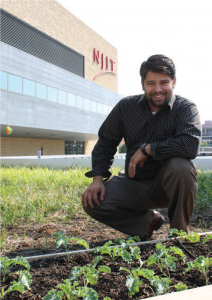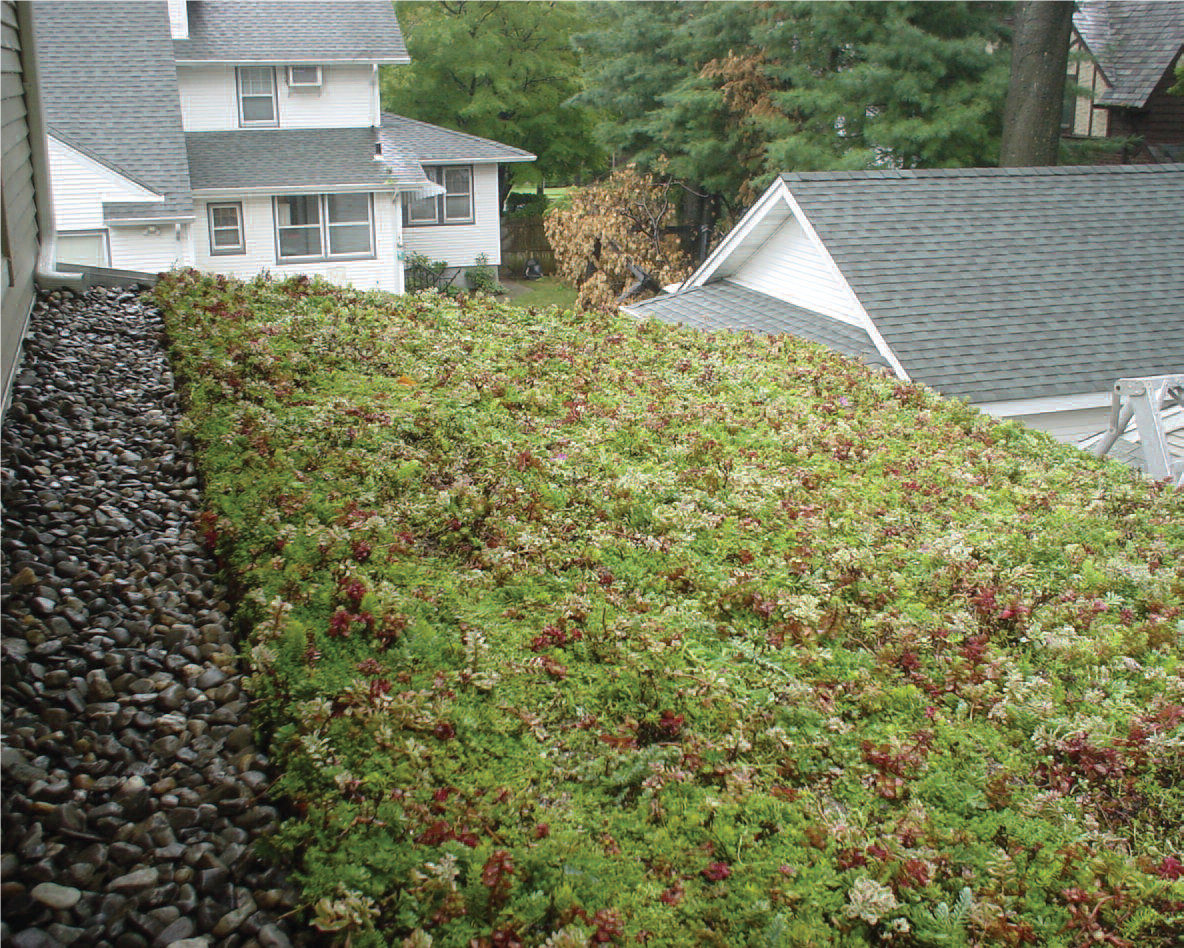In New Jersey, over-the-top gardening is no longer flying under the radar.
As forest and farmland have yielded to suburban sprawl, cities large and small across the country are reclaiming the urban landscape and becoming greener. Much of this green revolution is taking root high above street level, in the form of mini-parks and farms sprouting from the unlikeliest of places. Fueled by increased sustainability concerns and the burgeoning locavore movement, rooftop gardens are everywhere—out of sight but, increasingly, top of mind. Take our nation’s capital, for example. In 2012, Washington DC added 1.3 million square feet of rooftop garden space. From ancient times, when Nebuchadnezzar hung world-wonder gardens from the terraces of his Babylonian palace, rooftop gardens have captured our imaginations.
Even on a micro scale, what apartment dweller hasn’t tended herbs and potted tomatoes on a patio or fire escape? Well, now “agri-tecture” has become big business. In Brooklyn, rooftop farms are practically commonplace— beehives hum, chickens lay eggs, and organic vegetables begin their farm-to-table journey. The benefits of these Edenic aeries are manifold. Besides creating natural spaces and gardens, and optimizing space, the greening of roofs increase sustainability by reducing and reusing storm water, countering carbon dioxide, improving quality of life and the health of building occupants. To some, a green roof is a purpose; to others it is a passion. One extreme example is the Pasona, a human resource conglomerate in Tokyo. It’s headquarters is green inside and out with, a roof sprouting sweet potatoes, green interior and exterior walls, and a hydroponic rice-paddy foyer, which is harvested several times a year. The rooftop movement differs from country to country, and region to region, but make no mistake— it has definitely taken root here in New Jersey.


77 Hudson • Jersey City Installed by Let It Grow, of River Edge, NJ Four years ago, this rooftop garden was installed in Jersey City on an 11-story paring building structure between a KHovnanian condo high rise and an Equity Residential rental tower. This was a huge engineering feat, as much of the parkland material was installed by crane. Built on Styrofoam and two feet of fill on nearly an acre, it includes a pool, hot tub, dog run, African fire pit, children’s play area and even a landscaped hill. Undeterred when Hurricane Sandy struck and wind-stripped the soil (leaving roots exposed), the building replaced the landscape with heavier soils, planted more densely and installed a glass windshield. According to Randy Brosseau, KHovnanian Area President, it’s all worth it: “The garden adds a lot of value to our residents’ lives, whether using the facilities, enjoying the parkland or enjoying the view of the plantings. The green roof to many is a good reason to buy at 77 Hudson.”
 NJIT Cafeteria Garden • Newark Installed in 2010 by “My Local Gardener” with Peter Fischbach and Julie Aiello You can’t get fresher or healthier food than the vegetables that are served at NJIT’s cafeteria. For three years, NJIT students and faculty have enjoyed farm-to-table vegetables harvested from an elevated 220 sq. ft. organic roof garden outside the student pub. On an existing “green” roof—which already had a faucet—the design team installed 10 recycled flower boxes and filled them with a light soil that wouldn’t weigh down the roof. According to NJIT chef Peter Fischbach (right), who envisioned the project with Julie Aiello, Director of Marketing and Sustainability for Gourmet Dining Services (GDS), the campus food purveyor, they plant rotating crops of healthy vegetables four to five times a growing season, including lettuce, beets, tomatoes, squash, broccoli, kale, collard greens, Brussels sprouts, peppers and peas. They also grow a large selection of herbs, which are used to season the food. Meanwhile, the garden has germinated other campus organic gardens. According to Fischbach, “The project has been so successful that it has inspired other colleges serviced by GDS—Seton Hall, Manhattan College, Kean University, FDU in Madison. And we are preparing to put in a garden at Bloomfield College.”
NJIT Cafeteria Garden • Newark Installed in 2010 by “My Local Gardener” with Peter Fischbach and Julie Aiello You can’t get fresher or healthier food than the vegetables that are served at NJIT’s cafeteria. For three years, NJIT students and faculty have enjoyed farm-to-table vegetables harvested from an elevated 220 sq. ft. organic roof garden outside the student pub. On an existing “green” roof—which already had a faucet—the design team installed 10 recycled flower boxes and filled them with a light soil that wouldn’t weigh down the roof. According to NJIT chef Peter Fischbach (right), who envisioned the project with Julie Aiello, Director of Marketing and Sustainability for Gourmet Dining Services (GDS), the campus food purveyor, they plant rotating crops of healthy vegetables four to five times a growing season, including lettuce, beets, tomatoes, squash, broccoli, kale, collard greens, Brussels sprouts, peppers and peas. They also grow a large selection of herbs, which are used to season the food. Meanwhile, the garden has germinated other campus organic gardens. According to Fischbach, “The project has been so successful that it has inspired other colleges serviced by GDS—Seton Hall, Manhattan College, Kean University, FDU in Madison. And we are preparing to put in a garden at Bloomfield College.”
Revel • Atlantic City Installed by Cagley & Tanner of Las Vegas Last summer, Revel, the upscale resort in Atlantic City, opened a two-acre Sky Garden to recall the beauty and ambiance of the great Atlantic seaside resorts of the past—following the practice of situating a resort in a garden that descends to the beach. While the hotel’s architecture is 21st century, the designers sought to enhance the vista with a mix of nostalgia and modern ingenuity. This homage to the lawns that swept down to the ocean begins, in fact, at 114 feet above sea level, and is landscaped for seasonal interest—with 20,000 plants ranging from native sea grasses to Japanese Black Pines that create a Pine Grove surrounding an outdoor fireplace. (Planting the large pines required creating a deep recessed area under the roof surface to allow for root growth.) Their hard work paid off, as the garden successfully weathered the forces of Sandy.
Extra Space Storage • North Bergen Extra Space Storage, with its landscaped roof, definitely wins the “good neighbor award.” While only the on-site manager has access to Extra Space Storage’s rooftop garden, the company installed the nearly half-acre landscaping to “ensure an aesthetically pleasing view for all for the high-rise condo properties that surround our building,” explains Clint Halverson, Vice President for Corporate Communications and Investor Relations. The mechanics of creating a rooftop garden involve a number of variables: structural support, irrigation, installation stories above ground level, wind buffers and— not the least of concerns—waterproofing, root barriers and drainage. However, the rewards also are significant. Gardens insulate, reducing heating and cooling costs up to 30%. And they shield a building from urban noise. In the end, though, the greatest selling point of a rooftop garden is its aesthetic and recreational appeal. In a world of concrete, glass and steel, we welcome anything that speaks so eloquently to our senses and spirit.
Editors Note: Sarah Rossbach is the author of Feng Shui: The Art of Chinese Placement, which was described by The New York Times as the “bible of the practice.”





